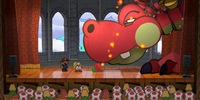
Review
"Paper Mario: The Legend of the Aeon Gate" preview: The Switch remake shines with revamped graphics and sound
by Domagoj Belancic
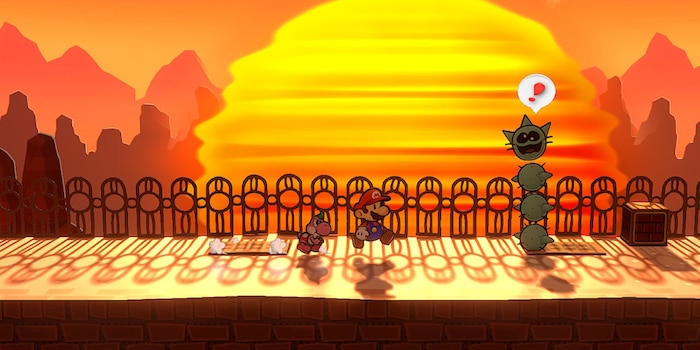
The Switch remake of Paper Mario: The Thousand-Year Door impresses with quirky humour, completely redesigned graphics and a new soundtrack. But you have to be patient to enjoy this role-playing game.
Mario role-playing games are something very special. They impress with quirky humour and surprise with unusual game mechanics. I’ve played and loved most of these RPG wonders.
Unfortunately, I missed Gamcube classic Paper Mario: The Thousand-Year Door for Nintendo’s purple lunchbox back then. The Switch remake offers me the opportunity to close this Mario knowledge gap. But even for fans of the original, it’s worth taking another trip into the crazy paper world.
Once again, Mario has to free his beloved Princess Peach from the clutches of a villain. For once, Bowser doesn’t have his lizard finger in this pie. Peach has been abducted by an alien (?) villain during a treasure hunt. He wants to use the princess to get his hands on a legendary treasure, hidden behind the eponymous magical Thousand-Year Door. Donning the boots of a bouncing plumber, it’s my job to put a stop to these alien villains, free Peach and recover the legendary treasure.
Easier said than done, as the magic gate will only open if Mario collects seven stars scattered across the world.
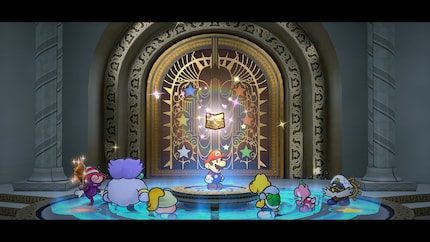
The story stays the same. Those seven magic stars are merely a pretext for the plumber to go on his adventure and beat up numerous enemies in turn-based battles.
But that’s okay. The Mario role-playing games have never shone with highly complex stories, but with excellently written dialogue, unique characters and exciting locations. Same with The Thousand-Year Door.
The generic story stands in stark contrast to the wonderful game environments I explore in search of seven stars. I’m constantly transported to new, incredibly varied microcosms, both visually and in terms of play.
One of my favourites is the flying city of Glitzville. In it, I take part in a grandiose fighting tournament and uncover a dark secret behind the event. Or Twilight Town, where I fight a poltergeist that turns villagers into pigs. But my absolute highlight is the Excess Express. In this stage, I solve a crime as the assistant to a master penguin detective.
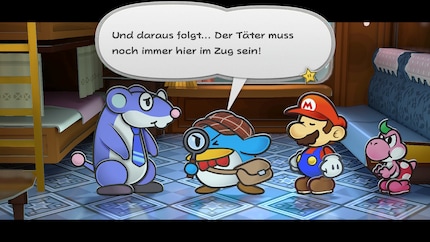
All the various worlds are bursting with original ideas. The characters I meet there also always bring a smile to my face. Every line of dialogue is full of wit, surprising me with fourth wall breaks. Suddenly, an NPC turns directly to me: «Hey, you in front of the screen. Listen up.» An enemy I’ve just beaten up complains to me: «Just because you have the lead role in a video game, you think you can solve everything with violence.» I’ve been caught red-handed.
The game knows that, objectively speaking, its story is absolute garbage. This only allows it to further play in dialogue filled with meta commentary. It’s exactly my sense of humour and a big reason why I like Mario RPGs so much.
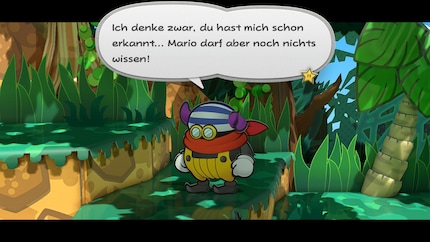
The numerous characters who join Mario’s team in the course of his adventure are also fabulous. I get to know a new team member in each chapter. The dialogue for each character is excellently written. Mario’s friends also have special skills I can use when exploring the paper world.
Goomba archaeologist and notorious know-it-all Goombella gives me background information on the game world and valuable tips at the touch of a button. Lascivious cloud spirit Madame Flurrie was once a respected theatre actress – in my party, she blows away opponents and obstacles with her special power. But my favourite is the ultra-cute Yoshi Kid, whom I ride and jump around on.
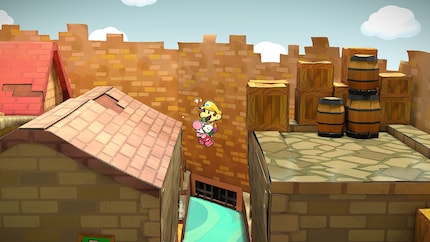
Of course, the search for my magic stars doesn’t just involve talking and exploring. I spend a large part of my adventure in turn-based battles.
Mario doesn’t have to fight various nasties alone, but can count on the help of his party members. Some shine in battle with offensive abilities – such as the fierce Admiral Bobbery, who blows up opponents with explosive attacks. Other party members, such as witch Vivian, are helpful on the defensive and protect Mario from enemy attacks with magic.
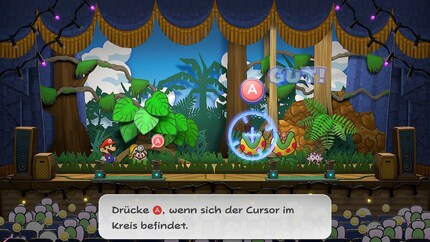
Mario himself attacks with his hammer, by jumping or with items. The combat system is kept simple and accessible for beginners. As is typical for Mario RPGs, I can boost my attacks and defence with perfectly timed button presses. This makes the turn-based battles more interactive and unpredictable than in other role-playing games. I never know whether I’ll hit a jump perfectly or whether I’ll fail and miss my opponent. The increased interactivity makes the combat system exciting, even for those who don’t like role-playing games.
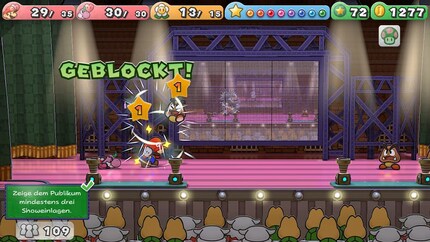
In addition to regular attacks, there are also magical special moves. But as my magic resources aren’t infinite, I can’t use them willy-nilly.
When executing special moves, I have to mash the controller even harder than with regular attacks. Some moves even degenerate into little mini-games. This is fun at first, but develops into a sometimes tedious game mechanic in some instances. Later in the game, I find myself deliberately not using certain attacks because I don’t feel like playing the unnecessarily long mini-game.
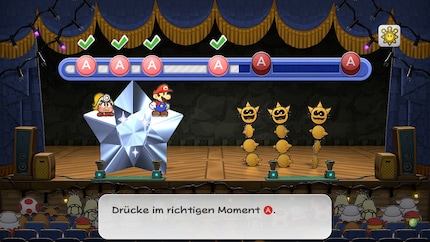
Battles take place on a theatre stage. Why? No idea. The game never explains it. Doesn’t matter though, as the unusual combat setting is convincing in terms of gameplay. The theatre twist sets the turn-based battles apart from other Mario role-playing games.
If I shine on stage with successful moves, I fill up my magic for special attacks thanks to applause from the audience. But the stage also brings peril: some of my attacks cause certain props to collapse or the lighting to fall on Mario’s head. I also always have to keep an eye on the audience. Some spectators throw helpful items onstage or throw stones at Mario’s team. In short, I never know what surprises the theatre scene will throw at me, and I always have to be on my guard.
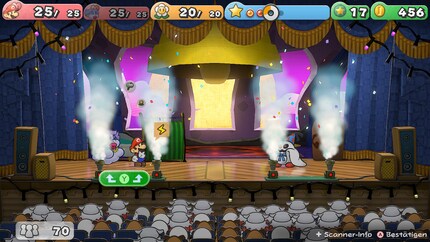
In addition to the combat system, levelling up Mario and his friends is also kept simple. The game doesn’t overwhelm me with thousands of options and statistics, but reduces the RPG elements to the bare essentials.
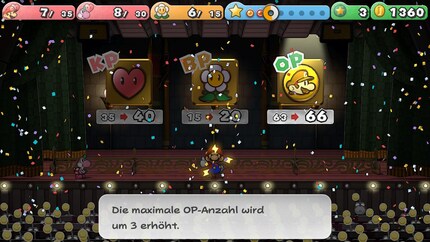
For RPG pros, the game offers an optional badge system that provides additional strategic depth. When I equip them on Mario, I adapt his abilities to my playing style. Some badges are simple and increase Mario’s defence or offence. Others, in the right combination, open up exciting new strategic possibilities in battle. If the game is too easy for you, there are even medals that significantly increase the difficulty with nasty handicaps.
I have a lot of fun experimenting with the various badge abilities and build up a blatantly overpowered Mario build in the course of my adventure. If you don’t fancy the additional complexity, you can completely ignore badges.
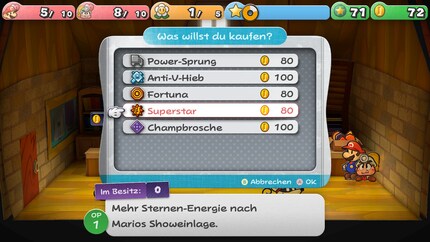
The Switch re-release of Paper Mario: The Thousand-Year Door is a full remake of the original, not just a remaster. In other words, the graphics and sound have been completely overhauled.
The game looks gorgeous on both my 77-inch TV and the Switch’s small OLED screen. Compared to the original, the remake impresses with a new aspect ratio, higher resolution and game environments developed from scratch. A lot of work was done on the lighting in particular. Both artificial and natural light sources bathe scenes and characters in an atmospheric light. The beautiful visual presentation is accompanied by catchy songs that sound much more energetic and powerful than the music from the original.
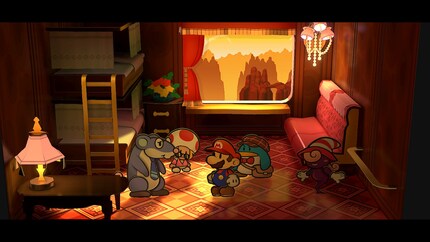
The only downside – the game only runs at 30 fps, while the original ran at 60. However, I don’t notice this limitation in a negative way while playing – The Thousand-Year Door isn’t a hectic game with fast movements. Only in situations with an extremely large number of enemies are there occasional noticeable frame rate drops.
You can find a detailed comparison between the original and the remake in my preview:
My excellent overall impression of the game is marred by some unnecessarily protracted game mechanics during the 30 hours of gameplay. On the one hand, there are the aforementioned lengthy mini-games in turn-based battles. On the other hand, the unnecessary backtracking also gets on my nerves.
Some of the main missions send me through the same, mostly linear game areas again and again, having to fight the same enemies every time. I have to walk from point A via point C to point B just so that I can then go back to point A again. Over and over again.
I often lose my bearings on boring errands. Which house do I have to go to again? Which pipe do I have to get into? No idea, as there are no detailed maps of the game areas. Fast travel? Also non-existent. The fact that Mario sometimes moves unbearably slowly through the world doesn’t help in these situations.
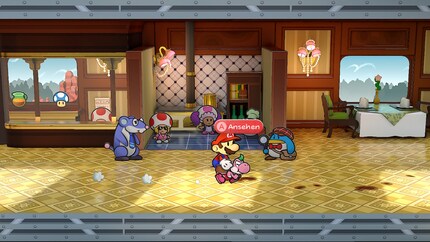
Another annoyance: the game world is divided into small sections connected to each other with loading screens. The transitions between the game world and combat sequences are also associated with short but noticeable loading sequences. The repeated waiting and excessive backtracking add up to an annoyance for impatient people like me as the game progresses. Too bad, the remake would’ve had the opportunity to modernise the gaming experience apart from audiovisual improvements.
Paper Mario: The Thousand-Year Door is a classic Mario role-playing game that every fan of the chubby plumber should try. If you’ve already played the original, it’s worth taking another trip into the paper world thanks to the completely revised graphics and soundscape.
The simplified role-playing mechanics and interactivity in turn-based battles make the game accessible even to beginners and RPG fans. The numerous game worlds impress with their quirky humour, excellently written characters and a beautiful paper look. I didn’t like the annoying backtracking and some tedious mechanics. Both slow down the pace unnecessarily as the game progresses.
Pro
Contra
My love of video games was unleashed at the tender age of five by the original Gameboy. Over the years, it's grown in leaps and bounds.
Which films, shows, books, games or board games are genuinely great? Recommendations from our personal experience.
Show all
Review
by Domagoj Belancic

Review
by Domagoj Belancic

Review
by Domagoj Belancic